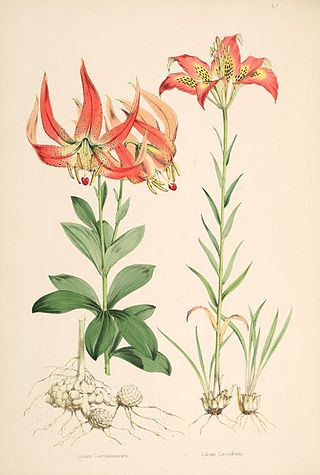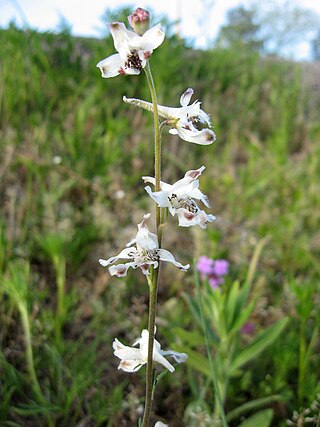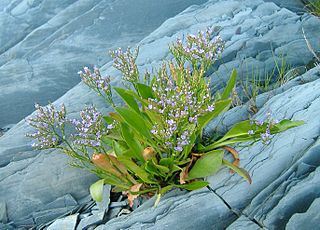Related Research Articles

Erythronium, the fawn lily, trout lily, dog's-tooth violet or adder's tongue, is a genus of Eurasian and North American plants in the lily family, most closely related to tulips. The name Erythronium derives from Ancient Greek ἐρυθρός (eruthrós) "red" in Greek, referring to the red flowers of E. dens-canis. Of all the established species, most live in North America; only six species are found in Europe and Asia.

Limonium is a genus of about 600 flowering plant species. Members are also known as sea-lavender, statice, caspia or marsh-rosemary. Despite their common names, species are not related to the lavenders or to rosemary. They are instead in Plumbaginaceae, the plumbago or leadwort family. The generic name is from the Latin līmōnion, used by Pliny for a wild plant and is ultimately derived from the Ancient Greek leimon.

Lycium is a genus of flowering plants in the nightshade family, Solanaceae. The genus has a disjunct distribution around the globe, with species occurring on most continents in temperate and subtropical regions. South America has the most species, followed by North America and southern Africa. There are several scattered across Europe and Asia, and one is native to Australia. Common English names for plants of this genus include box-thorn, wolfberry, and desert-thorn. There are about 70 to 80 species.

Lilium michauxii, commonly known as the Carolina lily, can be found in the southeastern United States from southern Virginia in the north to the Florida Panhandle in the south to eastern Texas in the west. Blooming is most common in July and August but can occur as late as October. It was named for the French botanist André Michaux, who traveled and did extensive research throughout the Southeast.

Geranium carolinianum is a species of geranium known by the common name Carolina crane's-bill, or Carolina geranium. This species is native to North America, where it is widespread and grows in many types of habitat. There are two varieties; Geranium carolinianum var. carolinianum and the Geranium carolinianum var. sphaerospermum. This is a summer or winter annual herb. It can be considered invasive depending on the region, when it is found in the United States it is considered to be native.

Erodium cygnorum is a species of herb native to Australia.
Staurolemma is a genus of lichenized fungi in the family Pannariaceae. The genus was circumscribed by German lichenologist Gustav Wilhelm Körber in 1867, with Staurolemma dalmaticum as the type species.
Caecum carolinianum is a species of minute sea snail, a marine gastropod mollusk or micromollusk in the family Caecidae.

Rhododendron minus var. minus, the Carolina azalea or Carolina rhododendron, is a rhododendron species native to the mountains of North Carolina, South Carolina, Tennessee, and Northeast Georgia. It is commonly known as Rhododendron carolinianum in the horticultural trade.
Catenochytridium is a genus of fungi in the family Endochytriaceae. The genus contains six species known from Japan and North America.

Pseudolycopodiella is a genus of non-seed plants in the Lycopodiaceae, long considered part of Lycopodium, but now recognized as a separate genus. It has 10–14 recognized species, only one in North America: Pseudolycopodiella caroliniana.

Allium carolinianum is a species of onions native to central and southern Asia. It grows in sunlit slopes at elevations of 3000–5000 m.

Delphinium carolinianum, commonly known as Carolina larkspur, is a species of perennial flowering plant in the buttercup family. It is native to central and eastern North America, where it is found in prairies and rocky glades. It produces blue to white flowers in the spring.
Cirsium carolinianum is a North American species of plants in the tribe Cardueae within the family Asteraceae. Common name is Carolina thistle or purple thistle or soft thistle or smallhead thistle. The species is native to the central and southern United States, from eastern Texas east to Virginia and the Carolinas, north to the Ohio Valley.

Myzinum is a genus of wasps in the family Thynnidae. There are 63 species presently recognized in Myzinum. They measure 7–24 mm. They are found in meadows, fields, and lawns. They parasitize white grubs, including Phyllophaga. They are used as biological controls.

Crocanthemum is a genus of flowering plants in the family Cistaceae. They are native to both North and South America where they are widespread. The common name frostweed relates to the ice crystals which form from sap exuding from cracks near the base of the stem in the late fall.

Limonium carolinianum, known variously as Carolina sealavender, canker root, ink root, marsh root, lavender thrift, American thrift, or seaside thrift, is a species of flowering plant native to the eastern shores of North America, from northern Mexico to Canada. It is a slow-growing perennial herb found in salt marshes and other maritime habitats. Its inflorescences are frequently harvested for use in cut flower arrangements.
Streptomyces geranii is a bacterium species from the genus of Streptomyces which has been isolated from the root of a Geranium carolinianum plant from the Mount Emei in China.
Calicium carolinianum is a species of lichen in the family Caliciaceae. It is endemic to the Gulf Coastal Plain region of the United States. The lichen contains norstictic acid, and has ascospores that measure 13–17 by 8–9 μm.

Bathelium carolinianum is a species of crustose lichen in the family Trypetheliaceae. It is found in the eastern United States.
References
- 1 2 Berdan HB. (1939). "Two new genera of operculate chytrids". American Journal of Botany. 26 (1): 459–63. doi:10.2307/2436568. JSTOR 2436568.
- ↑ Kirk PM, Cannon PF, Minter DW, Stalpers JA (2008). Dictionary of the Fungi (10th ed.). Wallingford, UK: CAB International. p. 120. ISBN 978-0-85199-826-8.